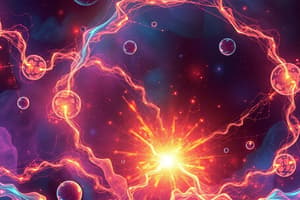Podcast
Questions and Answers
What determines the rate of a nucleophilic substitution reaction in an SN2 mechanism?
What determines the rate of a nucleophilic substitution reaction in an SN2 mechanism?
- Only the concentration of the substrate
- Only the concentration of the nucleophile
- The presence of a catalyst
- The concentration of both reactants (correct)
How does increasing the surface area of reactants affect the reaction rate?
How does increasing the surface area of reactants affect the reaction rate?
- It has no effect on the reaction rate
- It increases the contact between reactants (correct)
- It slows down the reaction rate due to more collisions
- It decreases the activation energy required
In a reaction where the transition state is formed from only one reactant, what affects the reaction rate?
In a reaction where the transition state is formed from only one reactant, what affects the reaction rate?
- Only the concentration of the single reactant (correct)
- Both reactants must be present
- Only the concentration of the product
- Only temperature influences the rate
Why is activation energy (Ea) important in chemical reactions?
Why is activation energy (Ea) important in chemical reactions?
What can be concluded about the reaction rates of A + B and C + D as the reaction proceeds?
What can be concluded about the reaction rates of A + B and C + D as the reaction proceeds?
What is the primary reason A and B do not immediately reach equilibrium with C and D?
What is the primary reason A and B do not immediately reach equilibrium with C and D?
Which statement best explains the effect of reactant concentration on the rate of reaction?
Which statement best explains the effect of reactant concentration on the rate of reaction?
How does the transition state contribute to the rate of reaction?
How does the transition state contribute to the rate of reaction?
In which type of reaction is the rate given by the equation Rate = k[A][B] applicable?
In which type of reaction is the rate given by the equation Rate = k[A][B] applicable?
What is the significance of the rate constant 'k' in the rate equation?
What is the significance of the rate constant 'k' in the rate equation?
Flashcards
Transition State
Transition State
A high-energy intermediate state in a chemical reaction that forms during the transformation of reactants to products.
Reaction Rate
Reaction Rate
The speed at which reactants are consumed and products are formed in a chemical reaction.
Rate Constant (k)
Rate Constant (k)
A proportionality constant in the rate law equation that reflects the rate of a reaction at a given temperature.
Reactant Concentration
Reactant Concentration
Signup and view all the flashcards
Law of Mass Action
Law of Mass Action
Signup and view all the flashcards
Reaction Rate - SN2
Reaction Rate - SN2
Signup and view all the flashcards
Reaction Rate - SN1
Reaction Rate - SN1
Signup and view all the flashcards
Activation Energy (Ea)
Activation Energy (Ea)
Signup and view all the flashcards
Surface Area & Reaction Rate
Surface Area & Reaction Rate
Signup and view all the flashcards
Study Notes
Reaction Rates
- Reaction rates are determined by the formation of transition states
- Reaction transition states are high energy intermediates between reactants and products
- Transition states are highly unstable and rapidly break down, either back to the reactants or to the products
- The rate of reaction is thus determined by how quickly the transition state forms
- Concentration of reactants involved in transition state formation affects reaction rate (law of mass action)
- For reactions with more than one reactant, the probability of collisions between reactant molecules affects the rate
- A collision is necessary, but also requires a minimum necessary energy (activation energy, Ea)
- The Arrhenius equation describes the relationship between the rate constant (k) and the temperature
Activation Energy
- Minimum energy needed for a reaction to occur
- Not all collisions result in a reaction; collisions must possess sufficient energy to overcome the activation energy barrier
- Increasing temperature increases the proportion of molecules with energy greater than the activation energy, therefore increasing the reaction rate
- The Arrhenius equation shows the relationship between rate constant and temperature
- The Arrhenius equation is non-linear; it shows an exponential increase in rate constant, with an increase in temperature
Catalysts
- Catalysts increase reaction rates by providing an alternative lower energy pathway
- Catalysts are unchanged after the reaction
- Heterogeneous catalysts are in a phase separate to the reactants, and often offer a surface on which the reaction takes place
- Homogeneous catalysts are in the same phase as the reactants, and are often chemicals that react with one reactant, but are regenerated when the product is formed
Equilibrium
- Reactions proceed in both forward and reverse directions, and at equilibrium, the rates of both reactions are equal
- When the concentration of products and reactants are constant and no more net change occurs.
- As products accumulate, the reverse reaction speed up and forward slows down, eventually leading to equilibrium
Studying That Suits You
Use AI to generate personalized quizzes and flashcards to suit your learning preferences.




